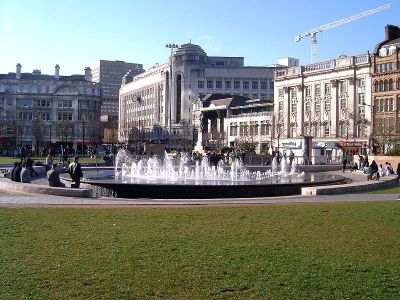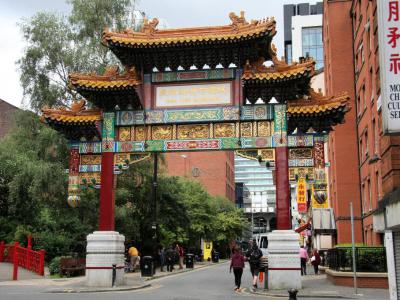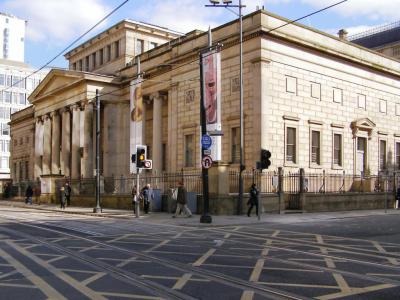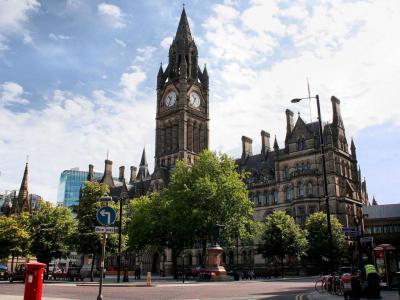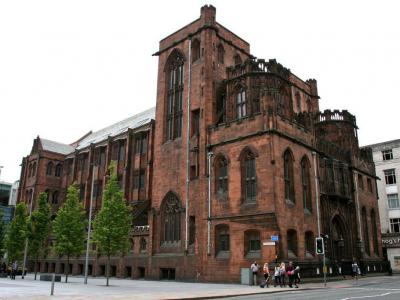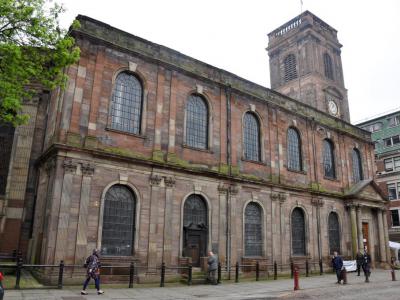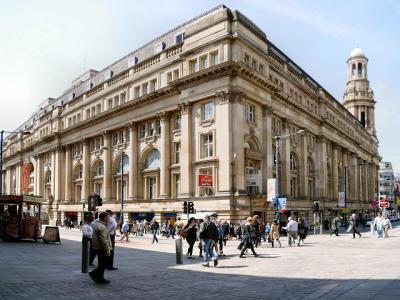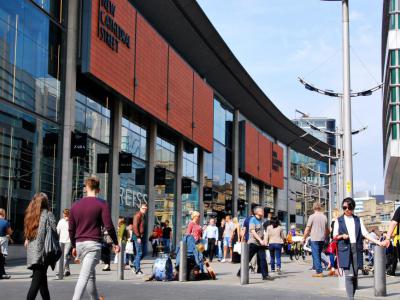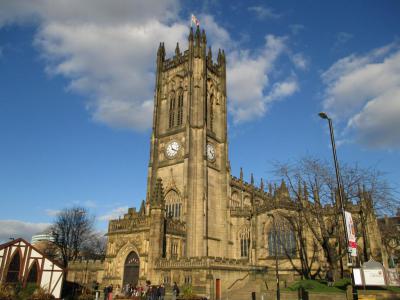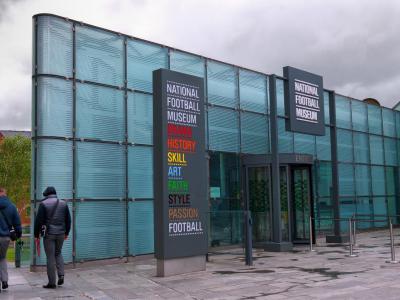
Manchester Introduction Walking Tour (Self Guided), Manchester
The seventh most populated city in England, Manchester is an important cultural, industrial and historic center.
The recorded history of Manchester began with the civilian settlement associated with the Roman fort established circa 79 AD on a sandstone bluff near the confluence of the rivers Medlock and Irwell. Having been a manorial township throughout the Middle Ages, Manchester enjoyed rapid expansion at the turn of the 19th century.
The unplanned urbanization brought on by a boom in textile manufacture, during the Industrial Revolution, saw Manchester become the world's first industrialized area, subsequently earning it the city status in 1853. The Manchester Ship Canal, opened in 1894, directly linking the city to the Irish Sea, 36 miles (58 km) to the west, facilitated the creation of the Port of Manchester.
Today Manchester is the second most visited city in the UK, after London, notable for its architecture, culture, music, scientific and engineering output, as well as social impact, sports clubs and transport connections.
If you're keen on history, visit the John Rylands Library to see the earliest extant New Testament text written on a piece of papyrus; dated 125–175 AD, it is almost 2,000 years old! No architecture buff should pass by the Manchester Town Hall – one of the best examples of Victorian, Neo-Gothic municipal building in the UK – erected in 1877, at the height of the city's industrial might.
And if you are a football fan, make way to the National Football Museum as a matter of must on your Manchester itinerary. The museum has on display a huge number of fascinating photos and historic objects, including shirts and shoes worn by football legends, such as Pele, Stanley Matthews, Diego Maradona and more.
To acquaint yourself with these and other prominent attractions of modern Manchester, take this self-guided walking tour!
The recorded history of Manchester began with the civilian settlement associated with the Roman fort established circa 79 AD on a sandstone bluff near the confluence of the rivers Medlock and Irwell. Having been a manorial township throughout the Middle Ages, Manchester enjoyed rapid expansion at the turn of the 19th century.
The unplanned urbanization brought on by a boom in textile manufacture, during the Industrial Revolution, saw Manchester become the world's first industrialized area, subsequently earning it the city status in 1853. The Manchester Ship Canal, opened in 1894, directly linking the city to the Irish Sea, 36 miles (58 km) to the west, facilitated the creation of the Port of Manchester.
Today Manchester is the second most visited city in the UK, after London, notable for its architecture, culture, music, scientific and engineering output, as well as social impact, sports clubs and transport connections.
If you're keen on history, visit the John Rylands Library to see the earliest extant New Testament text written on a piece of papyrus; dated 125–175 AD, it is almost 2,000 years old! No architecture buff should pass by the Manchester Town Hall – one of the best examples of Victorian, Neo-Gothic municipal building in the UK – erected in 1877, at the height of the city's industrial might.
And if you are a football fan, make way to the National Football Museum as a matter of must on your Manchester itinerary. The museum has on display a huge number of fascinating photos and historic objects, including shirts and shoes worn by football legends, such as Pele, Stanley Matthews, Diego Maradona and more.
To acquaint yourself with these and other prominent attractions of modern Manchester, take this self-guided walking tour!
How it works: Download the app "GPSmyCity: Walks in 1K+ Cities" from Apple App Store or Google Play Store to your mobile phone or tablet. The app turns your mobile device into a personal tour guide and its built-in GPS navigation functions guide you from one tour stop to next. The app works offline, so no data plan is needed when traveling abroad.
Manchester Introduction Walking Tour Map
Guide Name: Manchester Introduction Walking Tour
Guide Location: England » Manchester (See other walking tours in Manchester)
Guide Type: Self-guided Walking Tour (Sightseeing)
# of Attractions: 10
Tour Duration: 2 Hour(s)
Travel Distance: 2.5 Km or 1.6 Miles
Author: alexander
Sight(s) Featured in This Guide:
Guide Location: England » Manchester (See other walking tours in Manchester)
Guide Type: Self-guided Walking Tour (Sightseeing)
# of Attractions: 10
Tour Duration: 2 Hour(s)
Travel Distance: 2.5 Km or 1.6 Miles
Author: alexander
Sight(s) Featured in This Guide:
- Piccadilly Gardens
- Chinatown
- Manchester Art Gallery
- Manchester Town Hall
- John Rylands Library
- St Ann's Church
- Royal Exchange Theatre
- New Cathedral Street
- Manchester Cathedral
- National Football Museum
1) Piccadilly Gardens
Piccadilly Gardens is one of the most popular public parks in Manchester’s densely populated city center. It is located at the end of Market Street, in one of the city’s main shopping districts. Its namesake railway station, Manchester Piccadilly, lies a ten minute walk away, whilst the gardens have a dedicated Metrolink tram interchange, with a bus station and ticket office to the south. The gardens were redesigned in the years leading up to the 2002 Commonwealth Games, when many of Manchester’s streets, open spaces and buildings were redeveloped. The gardens now represent the mixture of ancient and modern that has made Manchester an ever more popular tourist destination.
The site of Piccadilly Gardens once housed Manchester Royal Infirmary, and was converted into a green space when the hospital was relocated in 1910. The park has been redeveloped on a number of occasions, and contains a number of statues of famous British figures, including Queen Victoria and Sir Robert Peel. Walking in the gardens, you can look out on many of Manchester’s listed buildings, including the Brunswick Hotel, as well as modern creations like Piccadilly Plaza and the City Tower. The gardens were redesigned in a collaborative project between local and international architects, with the addition of the distinctive central fountains and a pavilion to shield the gardens from increased traffic noise.
The site of Piccadilly Gardens once housed Manchester Royal Infirmary, and was converted into a green space when the hospital was relocated in 1910. The park has been redeveloped on a number of occasions, and contains a number of statues of famous British figures, including Queen Victoria and Sir Robert Peel. Walking in the gardens, you can look out on many of Manchester’s listed buildings, including the Brunswick Hotel, as well as modern creations like Piccadilly Plaza and the City Tower. The gardens were redesigned in a collaborative project between local and international architects, with the addition of the distinctive central fountains and a pavilion to shield the gardens from increased traffic noise.
2) Chinatown
Manchester Chinatown is an ethnic enclave in the city centre, and is the second largest Chinatown in the United Kingdom and the third largest in Europe. Apart from Chinese, it contains a multitude of Thai, Japanese, Nepali, Vietnamese, Singaporean and Malaysian restaurants, shops, bakeries and supermarkets.
One of the Chinatown's most noticeable landmarks is the archway adorned with dragons and phoenixes, aka “paifang”, on Faulkner Street, a gift from Manchester City Council to the Chinese community. It was custom-built in China and shipped over to Manchester in three containers. The construction commenced during Christmas 1986 and was completed by Easter 1987.
Another Chinatown landmark is the Guardian telephone exchange. The building is now owned by BT and used for communications work, though it was constructed for an entirely different purpose. It sits atop an underground bunker, constructed between 1949 and 1954, and was paid for by the NATO. The bunker was a fallout shelter designed to protect officials in the event of an atomic attack, and features over four miles of tunnels. The media were banned from revealing the bunker's existence until 1967.
One of the Chinatown's most noticeable landmarks is the archway adorned with dragons and phoenixes, aka “paifang”, on Faulkner Street, a gift from Manchester City Council to the Chinese community. It was custom-built in China and shipped over to Manchester in three containers. The construction commenced during Christmas 1986 and was completed by Easter 1987.
Another Chinatown landmark is the Guardian telephone exchange. The building is now owned by BT and used for communications work, though it was constructed for an entirely different purpose. It sits atop an underground bunker, constructed between 1949 and 1954, and was paid for by the NATO. The bunker was a fallout shelter designed to protect officials in the event of an atomic attack, and features over four miles of tunnels. The media were banned from revealing the bunker's existence until 1967.
Sight description based on Wikipedia.
3) Manchester Art Gallery
Manchester Art Gallery, formerly Manchester City Art Gallery, is a publicly owned art museum on Mosley Street in the city center. The main gallery premises were built for a learned society in 1823 and today its collection occupies three connected buildings, two of which were designed by Sir Charles Barry who is known for his major contribution to the use of Italianate architecture in Britain. Both Barry's buildings are designated as historic heritage in England.
Manchester Art Gallery is free to enter and open seven days a week. It houses many works of local and international significance and has a collection of more than 25,000 objects. Annually, the museum receives more than half a million visitors.
Manchester Art Gallery is free to enter and open seven days a week. It houses many works of local and international significance and has a collection of more than 25,000 objects. Annually, the museum receives more than half a million visitors.
Sight description based on Wikipedia.
4) Manchester Town Hall (must see)
Manchester Town Hall was built in 1877, at the height of the city’s industrial expansion, and is one of the UK’s finest examples of neo-Gothic architecture, designed by architect Alfred Waterhouse.
The history of this industrial northern city is intrinsic to the design and creation of this building. Waterhouse used hard-wearing ‘Spinkwell stone’ to create a structure that could survive the heavy air pollution found in Victorian Manchester. In addition, Waterhouse’s design was chosen due to its clear contrast to the neoclassical architecture found in Liverpool, Manchester’s local rival during the industrial age. The frontage of the Town Hall and Bell Tower form one of Manchester’s most recognisable images, and is covered with ornate sculptures depicting the history of the city.
The extension building was completed in the 1930s to cater for Manchester’s growing need for a larger council office. Together, the Town Hall and its iconic Bell Tower have been described as resembling a miniature version of London’s Palace of Westminster, and even have been used as its substitute in film and TV, including recent productions “State of Play” and “The Iron Lady.”
The history of this industrial northern city is intrinsic to the design and creation of this building. Waterhouse used hard-wearing ‘Spinkwell stone’ to create a structure that could survive the heavy air pollution found in Victorian Manchester. In addition, Waterhouse’s design was chosen due to its clear contrast to the neoclassical architecture found in Liverpool, Manchester’s local rival during the industrial age. The frontage of the Town Hall and Bell Tower form one of Manchester’s most recognisable images, and is covered with ornate sculptures depicting the history of the city.
The extension building was completed in the 1930s to cater for Manchester’s growing need for a larger council office. Together, the Town Hall and its iconic Bell Tower have been described as resembling a miniature version of London’s Palace of Westminster, and even have been used as its substitute in film and TV, including recent productions “State of Play” and “The Iron Lady.”
5) John Rylands Library (must see)
The John Rylands Library is housed within a Victorian Gothic building, located on Deansgate in Manchester City Center. Opened to the public in 1900, the building was designed by Basil Champneys, at the request of John Rylands’ widow. Rylands himself was Manchester’s foremost textile manufacturer, and became the city’s first multi-millionaire. The philanthropy of businessmen like Rylands greatly aided the development of the city at the turn of the 20th century.
Since its creation, the library has been extended and enlarged seven times, and is now operated by the University of Manchester. The most valuable special collections found in the university library have been moved to John Rylands Library, so as to allow the public greater access to them. The most notable of these artifacts is the earliest discovered manuscript of a New Testament text. The library also contains personal effects of public figures such as Elizabeth Gaskell and John Dalton.
The stunning, ornate Gothic interior of the library has made it a popular tourist attraction in its own right, and the university offers regular tours, allowing visitors to peek behind the scenes of this famous building.
Since its creation, the library has been extended and enlarged seven times, and is now operated by the University of Manchester. The most valuable special collections found in the university library have been moved to John Rylands Library, so as to allow the public greater access to them. The most notable of these artifacts is the earliest discovered manuscript of a New Testament text. The library also contains personal effects of public figures such as Elizabeth Gaskell and John Dalton.
The stunning, ornate Gothic interior of the library has made it a popular tourist attraction in its own right, and the university offers regular tours, allowing visitors to peek behind the scenes of this famous building.
6) St Ann's Church
St. Ann’s Church is a Grade I listed, 18th century temple located in front of St. Ann’s Square, at the heart of Manchester’s shopping district, where the fashionable shopping avenues of New Cathedral Street and Barton Arcade converge. The church was consecrated at this spot in 1712, when Manchester was little more than a rural parish town. Named after St. Anne, the church’s shortened name is a reference to Lady Ann Bland who was its first patron. The building was redeveloped during the Victorian era, with its red Collyhurst sandstone exterior replaced with harder wearing stone, and stained glass windows installed.
The completion of the church marked the rise of Manchester as an urban centre. Within ten years, St. Ann’s Square had been laid out in front of the church, based on the fashionable squares found in Bath and London. The church thus became so central to the city’s development that its bell tower is still considered the centre of the city. The benchmark which surveyors used to measure distances to Manchester’s satellite towns can still be seen at the base of the tower. A Church of England place of worship, St. Ann’s Church welcomes visitors and still holds regular Sunday services.
The completion of the church marked the rise of Manchester as an urban centre. Within ten years, St. Ann’s Square had been laid out in front of the church, based on the fashionable squares found in Bath and London. The church thus became so central to the city’s development that its bell tower is still considered the centre of the city. The benchmark which surveyors used to measure distances to Manchester’s satellite towns can still be seen at the base of the tower. A Church of England place of worship, St. Ann’s Church welcomes visitors and still holds regular Sunday services.
7) Royal Exchange Theatre
Located on New Cathedral Street in Manchester’s bustling city centre, the Royal Exchange building houses a theatre and shopping arcade. Whilst the building has stood on this site since the late 18th century, it has only been used as a theatre since the 1970s. Built in the Georgian era and upgraded in Victorian times, the Royal Exchange building formed the heart of Manchester’s commercial district, and was the venue for the trading of textiles manufactured in the city’s famous cotton mills. By 1931, the main hall was the largest trading room in the country. The building’s heyday as a trading centre was brought to an abrupt end by the Blitz, when the trading hall was badly damaged. The building was left empty after World War 2.
Facing possible demolition, the Royal Exchange was saved and converted into a theatre and shopping centre. The Royal Exchange Theatre was opened in 1976 by Sir Laurence Olivier. The main theatre space is designed ‘in the round’, meaning that the stage and performers are completely surrounded by the audience. It is the largest theatre in the round in the UK, and hosts up to 350 productions each year. The bulk of the theatre’s schedule is built around stage classics from Shakespeare and Chekhov, although touring foreign theatre groups and musicians play there regularly. The theatre has a box office, contained within the Exchange building.
Facing possible demolition, the Royal Exchange was saved and converted into a theatre and shopping centre. The Royal Exchange Theatre was opened in 1976 by Sir Laurence Olivier. The main theatre space is designed ‘in the round’, meaning that the stage and performers are completely surrounded by the audience. It is the largest theatre in the round in the UK, and hosts up to 350 productions each year. The bulk of the theatre’s schedule is built around stage classics from Shakespeare and Chekhov, although touring foreign theatre groups and musicians play there regularly. The theatre has a box office, contained within the Exchange building.
8) New Cathedral Street
New Cathedral Street is a modern, pedestrianised shopping street in the heart of central Manchester, close to Deansgate and halfway between the city’s two main train stations, Victoria and Piccadilly. While the street is a relatively modern addition, it has been built around two of Manchester’s most famous landmarks – the Royal Exchange theatre and arcade in the centre of the street, and St. Ann’s Church at the street’s southern end. As the name suggests, New Cathedral Street leads towards Manchester Cathedral, at the north end.
New Cathedral Street was built following major regeneration works in the downtown area, carried out after the infamous 1996 IRA bombing of Manchester’s city centre. New Cathedral Street is Manchester’s premier shopping destination, home to a number of boutique department stores, many of which are flagship stores for the North of England. The emergence of the street as a shopping hotspot has boosted Manchester’s reputation as a fashionable destination to visit. Established brands like Selfridge's and Marks & Spencer have their stores here alongside a host of designer names and outlets which have also taken up residence in New Cathedral Street. Among these are Harvey Nichols, Ted Baker, Hugo Boss, Burberry and Lacoste, to name but a few.
New Cathedral Street was built following major regeneration works in the downtown area, carried out after the infamous 1996 IRA bombing of Manchester’s city centre. New Cathedral Street is Manchester’s premier shopping destination, home to a number of boutique department stores, many of which are flagship stores for the North of England. The emergence of the street as a shopping hotspot has boosted Manchester’s reputation as a fashionable destination to visit. Established brands like Selfridge's and Marks & Spencer have their stores here alongside a host of designer names and outlets which have also taken up residence in New Cathedral Street. Among these are Harvey Nichols, Ted Baker, Hugo Boss, Burberry and Lacoste, to name but a few.
9) Manchester Cathedral (must see)
Manchester Cathedral has undergone extensive restoration works, both in the Victorian era and in recent years, following damage from the 1996 IRA bombing of the city centre. The cathedral has existed in some form on the site since medieval times, and holds artifacts that date back to Manchester’s existence as a Saxon settlement. The main body of this Gothic cathedral was originally constructed in the late 15th century, overseen by church warden James Stanley. The cathedral is Grade I listed and is the seat of the Bishop of Manchester. In accordance with British tradition, the presence of a cathedral is the reason that Manchester has been awarded city status.
The cathedral welcomes visitors to attend their services or to view the building’s interior. Admission is free, although donations are welcome. The cathedral is mostly wheelchair accessible, however parts of the Regiment Chapel and Quire are only accessible on foot. The cathedral runs and can be booked for a range of special events, such as weddings and other.
The cathedral welcomes visitors to attend their services or to view the building’s interior. Admission is free, although donations are welcome. The cathedral is mostly wheelchair accessible, however parts of the Regiment Chapel and Quire are only accessible on foot. The cathedral runs and can be booked for a range of special events, such as weddings and other.
10) National Football Museum (must see)
The National Football Museum is a museum at the Urbis building in Manchester city centre, founded to preserve, conserve and interpret important collections of football memorabilia. The museum was originally in Deepdale, Preston, Lancashire, but moved to Manchester in 2012. The National Football Museum holds a huge collection of football exhibits and memorabilia in a four-story building, and is the largest museum dedicated to the game of football in the world.
Here you will learn how football became the pass time of our lives. There are hundreds of fascinating photographs, memorable videos, and historic objects on display, including shirts worn by football greats such as Pele, Stanley Matthews, Diego Maradona and others.
The museum is very well-curated for visitors for learning the history of football as a game and the story behind the World Cup. For fun stuff, there is a penalty shootout zone for kids, so they can have hands-on, or more appropriately feet-on, experience of trying a penalty kick.
If you are football fan, the National Football Museum is a must-visit experience when in Manchester.
Here you will learn how football became the pass time of our lives. There are hundreds of fascinating photographs, memorable videos, and historic objects on display, including shirts worn by football greats such as Pele, Stanley Matthews, Diego Maradona and others.
The museum is very well-curated for visitors for learning the history of football as a game and the story behind the World Cup. For fun stuff, there is a penalty shootout zone for kids, so they can have hands-on, or more appropriately feet-on, experience of trying a penalty kick.
If you are football fan, the National Football Museum is a must-visit experience when in Manchester.
Walking Tours in Manchester, England
Create Your Own Walk in Manchester
Creating your own self-guided walk in Manchester is easy and fun. Choose the city attractions that you want to see and a walk route map will be created just for you. You can even set your hotel as the start point of the walk.
Manchester Historical Architecture Tour
Manchester’s architecture is rich in styles. Throughout centuries, the city has evolved in phases, each of which left its peculiar imprint on the city's architectural tapestry. Here, you can see medieval red-brick buildings coexisting harmoniously with concrete-and-glass structures from the modern era.
One notable landmark in Manchester is the Statue of Prince Albert, a regal monument... view more
Tour Duration: 1 Hour(s)
Travel Distance: 1.6 Km or 1 Miles
One notable landmark in Manchester is the Statue of Prince Albert, a regal monument... view more
Tour Duration: 1 Hour(s)
Travel Distance: 1.6 Km or 1 Miles
Edwardian Architecture Tour
A product of the Industrial Revolution, Manchester is noted for its warehouses, railway viaducts, cotton mills, and canals, reflecting the most ambitious and exciting phase of the city's history.
During the reign of King Edward VII, which spanned from 1901 to 1910, Manchester experienced a significant boom in architectural development. This period saw a shift towards more ornate and... view more
Tour Duration: 2 Hour(s)
Travel Distance: 2.6 Km or 1.6 Miles
During the reign of King Edward VII, which spanned from 1901 to 1910, Manchester experienced a significant boom in architectural development. This period saw a shift towards more ornate and... view more
Tour Duration: 2 Hour(s)
Travel Distance: 2.6 Km or 1.6 Miles
Useful Travel Guides for Planning Your Trip
Top 10 Cafes and Sweet Shops in Manchester
Heading up Oldham Street from Picadilly Gardens you arrive at The Northern Quarter; the ‘cool’ part of Manchester, think Brooklyn, Shoreditch, Le Marais; trendy young things with fancy haircuts frequent the coffee houses, boutique and vintage shops during the day and the bars once night-time...
The Most Popular Cities
/ view all
